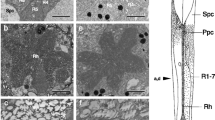Summary
Selective irradiation of digitonin extracts (pH 6.1) from dark-adapted eyes of the Sphingid mothDeihphila elpenor revealed three visual pigments with λmax at about 345, 440 and 520 nm. Prom the reaction of the chromophoric group with hydroxylamine it is concluded that these pigments are based on retinaldehyde, and therefore can be classed with rhodopsins. At −15 °C, each of the rhodopsins can completely (P 520) or partially (P 440 and P 345) be converted by light to acid metarhodopsin absorbing maximally at 480 ± 10 nm, which decay at room temperature to retinaldehyde and protein moiety. Spectrophotometric measurements on isolated retinae (pH 7.4) indicate that the metarhodopsins, in contrast to the findings on extracts, are thermostable in the photoreceptor membrane at room temperature. The results are compared with electrophysiological and microspectrophotometrical data. The different properties of the metarhodopsins in detergent solution and in the isolated retina are discussed.
Similar content being viewed by others
References
Abrahamson, E. W., Wiesenfeld, J. R.: The structure, spectra, and reactivity of visual pigments. In: Handbook of sens, physiol., vol. VII/1, Dartnall, H. J. A., ed., p. 69–121. Berlin-Heidelberg-New York: Springer 1972
Autrum, H., Zwehl, V. v.: Die spektrale Empfindlichkeit einzelner Sehzellen des Bienenauges. Z. vergl. Physiol.48, 357–384 (1964)
Brown, P. K., White, R. H.: Rhodopsin of the larval mosquito. J. gen. Physiol.59, 401–414 (1972)
Carlson, S. D., Philipson, B.: Microspeotrophotometry of the dioptric apparatus and compound rhabdom of the moth (Manduca sexta) eye. J. Insect Physiol.18, 1721–1731 (1972)
Dartnall, H. J. A.: The interpretation of spectral sensitivity curves. Brit. med. Bull.9, 24–30 (1953)
Daumer, K.: Reizmetrische Untersuchungen des Farbensehens der Bienen. Z. vergl. Physiol.38, 413–478 (1956)
Ephrussi, B., Beadle, G. W.: A technique of transplantation forDrosophila. Amer. Nat.70, 218–225 (1936)
Frisch, K. v.: Der Farbensinn und Formensinn der Bienen. Zool. Jb. Abt. allg. Zool. u. Physiol.35, 1–182 (1914)
Goldsmith, T. H.: The visual system of the honeybee. Proc. nat. Acad. Sci. (Wash.)44, 123–126 (1958)
Goldsmith, T. H.: The natural history of invertebrate visual pigments. In: Handbook of sens, physiol., vol. VII/1, Dartnall, H. J. A., ed., p. 685–719. Berlin-Heidelberg-New York: Springer 1972
Hamdorf, K., Höglund, G., Langer, H.: Mikrophotometrische Untersuchungen an der Retinula des NachtschmetterlingsDeilephila elpenor. Verh. dtsch. zool. Ges.65, 276–280 (1972)
Hamdorf, K., Höglund, G., Langer, H.: Photoregeneration of visual pigments in a moth. A microphotometric study. J. Comp. Physiol.86, 247–263 (1973)
Hamdorf, K., Schwemer, J., Gogala, M.: Insect visual pigment sensitive to ultraviolet light. Nature (Lond.)231, 458–459 (1971)
Höglund, G., Hamdorf, K., Rosner, G.: Trichromatic visual system in an insect and its sensitivity control by blue light. J. Comp. Physiol.86, 265–279 (1973)
Höglund, G., Struwe, G.: Pigment migration and spectral sensitivity in the compound eye of moths. Z. vergl. Physiol.67, 229–237 (1970)
Knoll, F.: Lichtsinn und Blütenbesuch des Falters vonDeilephila livornica. Z. vergl. Physiol.2, 329–380 (1924)
Kühn, A.: Über den Farbensinn der Bienen. Z. vergl. Physiol.5, 762–800 (1927)
Marak, G. E., Gallik, G. J., Cornesky, R. A.: Light-sensitive pigment in insect heads. Ophthal. Res.1, 65–71 (1970)
Paulsen, R., Schwemer, J.: Studies on the insect visual pigment sensitive to ultraviolet light: Retinal as the chromophoric group. Biochim. biophys. Acta (Amst.)283, 520–529 (1972)
Schwemer, J., Gogala, M., Hamdorf, K.: Der UV-Sehfarbstoff der Insekten: Photochemie in vitro und in vivo. Z. vergl. Physiol.75, 174–188 (1971)
Shichi, H.: Biochemistry of visual pigments II. Phospholipid requirement and opsin conformation for regeneration of bovine rhodopsin. J. biol. Chem.246, 6178–6182 (1971)
Snyder, A. W., Miller, W. H.: Fly colour vision. Vision Res.12, 1389–1396 (1972)
Wolken, J. J., Scheer, I. J.: An eye pigment of the cockroach. Exp. Eye Res.2, 182–188 (1963)
Zorn, M., Futtermann, S.: Properties of rhodopsin dependent on associated phospholipid. J. biol. Chem.246, 881–886 (1971)
Author information
Authors and Affiliations
Additional information
This work was supported by grants of the Deutsche Forschungsgemeinschaft to Prof. Dr. K. Hamdori (“Rezeptorphysiologie”).
We would like to thank Miss Gabriele Ziem for excellent technical assistance.
Rights and permissions
About this article
Cite this article
Schwemer, J., Paulsen, R. Three visual pigments inDeilephila elpenor (Lepidoptera, Sphingidae). J. Comp. Physiol. 86, 215–229 (1973). https://doi.org/10.1007/BF00696341
Received:
Issue Date:
DOI: https://doi.org/10.1007/BF00696341




